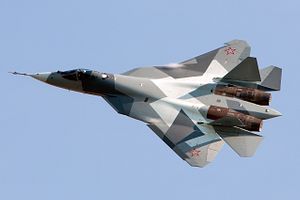Russia’s answer to the American F-22 and F-35 aircraft, the PAK FA T-50, will enter service with the Russian Armed Forces in 2017, Russian Air and Space Forces Commander Colonel-General Viktor Bondarev said over the weekend.
“Under the program, we will finish testing next year and will begin to receive the T-50 jets in 2017,” Bondarev told Sputnik News. Back in June, during the Paris Air Show, the head of United Russia’s Aircraft Corporation, had still talked about a potential 2016 or early 2017 induction date. However, serial deliveries are now slated to begin in 2017.
The Sukhoi PAK FA (Prospective Airborne Complex of Frontline Aviation) T-50 prototype — the name will change for the production aircraft — is a multi-role, single seat, twin-engine air superiority/deep air support fighter with stealth capabilities. First flown in 2010, it is expected to have a service life in the Russian Air and Space Forces of up to 35 years.
The PAK FA T-50 is intended to replace Russia’s fleet of MIG-29s and Su-27s and also serves as the basis for an Indo-Russian jointly developed fifth generation fighter aircraft under the Perspective Multi-role Fighter (PMF) program. However, as I noted previously, the Indo-Russian program has been plagued by delays, cost overrun, and unsteady technology.
So far, four PAK FA T-50 prototypes, along with two test beds of the fighter, have been delivered by Sukhoi to the Russian Air and Space Forces and are currently undergoing extensive testing. Three more prototypes are expected to be delivered by the end of this year. All in all, Russia plans to build 250 of the fifth generation aircraft, with 55 to enter service by 2020.
Last month, the CEO of Russia’s Tactical Missiles Corporation, Boris Obnosov, told reporters that the PAK FA T-50 will be equipped with a brand new missile, the X-58USHK, which boasts a top speed of around Mach 3.5. “The X-58USHK missile for the fifth-generation fighter is at the final stages of development … the flight speed will exceed 3.5 Mach,” he said. The new weapon will be placed inside the aircraft’s fuselage.
According to a Russian defense industry official, the PAK FAT T-50 is more of a robot than a flying plane and is also allegedly superior to the U.S. Air Force’s F-22. The T-50 “is already to some degree a flying robot, where the aviator fulfills the function not only of pilot, but is actually one of the constituent parts of the flying apparatus. That is, the reaction of the aviator is a part of the control loop,” he told RT.
“The T-50 is now ahead of not only all other fighters of the Russian Army, but also foreign models,” he continued. As an example, the official compared the planes’ stealth capabilities: “For example, the visibility of the American fifth-generation F-22 fighter is 0.3-0.4 square meters,” compared to the 0.1-1 square meter visibility of the PAK FAT T-50.































